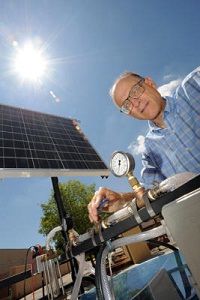NMSU students develop solar-powered water pump unit for farmers
 The rugged southwest landscape of New Mexico poses an interesting challenge for farmers in this sun-drenched state: How to pump water to water crops.
The rugged southwest landscape of New Mexico poses an interesting challenge for farmers in this sun-drenched state: How to pump water to water crops.
As their capstone project, a team of students at New Mexico State University (NMSU) developed a portable solar-powered water-pump demonstration unit to show farmers how they can use an alternative to gas-powered generators or the popular use of wind turbines to draw water from ground sources or move it from a source to storage.
There are more than 25,000 rural farms in New Mexico, according to NMSU. These farms sometimes lack access to the electric grid.
Farmers in the region have traditionally looked to wind turbines to draw water up from underground sources, but these can at times be problematic in requiring maintenance, which means climbing a tower or replacing mechanical equipment.
Some farmers use gas- or diesel-powered generators to draw water out of the ground or pump to another location as needed. But those systems rely on outside sources of fuel, which leaves farmers and ranchers subject to fluctuating fuel costs that continue to rise.
“The device is a solar-powered, water-pumping system used to pump water up from a ‘water well’ or from a surface feature, such as a lake or pond, to another location at a potentially higher elevation,” said engineering technology Professor Tom Jenkins, who heads the department's renewable energy program.
But the photovoltaic-powered demonstration unit developed by three mechanical engineering technology students Cody Anderson, Felicia Costales and Andres Galvan working with Craig Ricketts, an associate engineering technology professor, at NMSU’s College of Engineering and the Cooperative Extension Service, shows farmers and ranchers that there’s an alternative to both methods of extracting water.
The portable water pump can be taken to the farms to provide a live demonstration of the unit, according NMSU.
After watching how the system works, farmers and ranchers can work with the extension service to develop a system that fits their needs.
“The concept can be scaled to fairly large flows even though most of the applications for New Mexico would be for farmers or ranchers to water livestock, commonly in remote applications,” Jenkins said.
The students also created a spreadsheet-like tool that farmers can use to help design a solar-powered water pump system that will meet their needs. The tool also outlines costs.
"Users can enter information about the depth of their well, if it will be used for livestock and what type of livestock. The system will recommend a hardware layout for their given application," Ricketts said. "The spreadsheet will recommend the volume of water needed, how much storage will be needed as reserve for cloudy days, how many panels will be needed, pump and pipe size.”
Image courtesy of NMSU.



